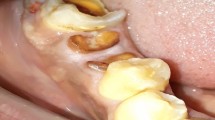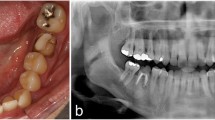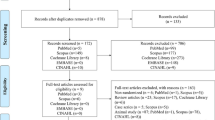Abstract
This study aims to investigate the therapeutic value of 660 nm light-emitting diode (LED) light irradiation on the strategies for treating experimental periodontal intrabony defects in vivo. Large-sized periodontal intrabony defects were created bilaterally on the mesial aspect of the maxillary second molars of 48 Sprague–Dawley rats, and the rats were equally divided into four treatment groups with primary wound intention (n = 6/treatment/time point), including open flap debridement alone (OD), barrier membrane alone (MB), xenograft alone (BG), and xenograft plus barrier membrane (MG). Each group received daily 0 or 10 J/cm2 LED light irradiation. The animals were sacrificed after 1 or 4 weeks. The treatment outcome was evaluated by gross observation of wound dehiscence and healing, micro-CT imaging for osteogenesis, and histological assessments for inflammatory cell infiltration and periodontal reattachment. With LED light irradiation, the extent of wound dehiscence was reduced, wound closure was accelerated, epithelial downgrowth was prevented, inflammation was reduced, and periodontal reattachment was promoted in all treatment strategies. Significant reduction of inflammation with LED light irradiation was noted at 1 week in the groups BG and MG (p < 0.05). Osteogenesis was significantly promoted only in the group OD at both time points (p < 0.05). Our study showed that 660 nm LED light accelerates mucoperiosteal flap healing and periodontal reattachment. However, the enhancement of osteogenesis appeared to be limited while simultaneously treating with a barrier membrane or xenograft.





Similar content being viewed by others
References
Graziani F, Gennai S, Cei S et al (2012) Clinical performance of access flap surgery in the treatment of the intrabony defect. A systematic review and meta‐analysis of randomized clinical trials. J Clin Periodontol 39:145–156
Caton JG, Greenstein G (1993) Factors related to periodontal regeneration. Periodontol 1:9–15
Rosen PS, Reynolds MA, Bowers GM (2000) The treatment of intrabony defects with bone grafts. Periodontol 22:88–103
Gottlow J, Nyman S, Karring T (1992) Maintenance of new attachment gained through guided tissue regeneration. J Clin Periodontol 19:315–317
Kao RT, Nares S, Reynolds MA (2015) Periodontal regeneration—intrabony defects: a systematic review from the AAP regeneration workshop. J Periodontol 86:S77–S104. doi:10.1902/jop.2015.130685
von Arx T, Broggini N, Jensen SS et al (2005) Membrane durability and tissue response of different bioresorbable barrier membranes: a histologic study in the rabbit calvarium. Int J Oral Maxillofac Implants 20:843–853
Nowzari H, MacDonald ES, Flynn J et al (1996) The dynamics of microbial colonization of barrier membranes for guided tissue regeneration. J Periodontol 67:694–702. doi:10.1902/jop.1996.67.7.694
Machtei EE (2001) The effect of membrane exposure on the outcome of regenerative procedures in humans: a meta-analysis. J Periodontol 72:512–516. doi:10.1902/jop.2001.72.4.512
Schindl A, Neumann R (1999) Low-intensity laser therapy is an effective treatment for recurrent herpes simplex infection. Results from a randomized double-blind placebo-controlled study. J Investig Dermatol 113:221–223
Schindl A, Schindl M, Pernerstorfer-Schön H et al (2000) Low-intensity laser therapy: a review. J Investig Med 48:312–326
Conlan MJ, Rapley JW, Cobb CM (1996) Biostimulation of wound healing by low-energy laser irradiation a review. J Clin Periodontol 23:492–496
Desmet KD, Paz DA, Corry JJ et al (2006) Clinical and experimental applications of NIR-LED photobiomodulation. Photomed Laser Surg 24:121–128
Chang PC, Chien LY, Ye Y et al (2013) Irradiation by light-emitting diode light as an adjunct to facilitate healing of experimental periodontitis in vivo. J Periodontal Res 48:135–143. doi:10.1111/j.1600-0765.2012.01511.x
Chang PC, Wang CY, Sheng-Chueh T (2014) Combination of LED light and platelet-derived growth factor to accelerate dentoalveolar osteogenesis. J Clin Periodontol 41:999–1006. doi:10.1111/jcpe.12301
Wang CY, Tsai SC, Yu MC et al (2015) Light-emitting diode irradiation promotes donor site wound healing of the free gingival graft. J Periodontol 86:674–681. doi:10.1902/jop.2015.140580
Chang P-C, Dovban AS, Lim LP et al (2013) Dual delivery of PDGF and simvastatin to accelerate periodontal regeneration in vivo. Biomaterials 34:9990–9997
Otsu N (1979) A threshold selection method from gray-level histograms. IEEE Trans Syst Man Cybern 9:62–66
Chang PC, Tsai SC, Jheng YH et al (2014) Soft-tissue wound healing by anti-advanced glycation end-products agents. J Dent Res 93:388–393. doi:10.1177/0022034514523785
Susin C, Fiorini T, Lee J et al (2015) Wound healing following surgical and regenerative periodontal therapy. Periodontol 2000(68):83–98. doi:10.1111/prd.12057
Schupbach P, Gaberthuel T, Lutz F et al (1993) Periodontal repair or regeneration: structures of different types of new attachment. J Periodontal Res 28:281–293
Renvert S, Garrett S, Nilveus R et al (1985) Healing after treatment of periodontal intraosseous defects. VI. Factors influencing the healing response. J Clin Periodontol 12:707–715
Behdin S, Monje A, Lin GH et al (2015) Effectiveness of laser application for periodontal surgical therapy: systematic review and meta-analysis. J Periodontol 86:1352–1363. doi:10.1902/jop.2015.150212
Newman MG, Takei H, Klokkevold PR et al (2011) Carranza’s clinical periodontology. Elsevier, Philadephia
Wang C, Tsai S, Yu M et al (2015) 660 nm LED light irradiation promotes the healing of the donor wound of free gingival graft. J Periodontol 86:674–681. doi:10.1902/jop.2015.140580
Wu JY, Chen CH, Yeh LY et al (2013) Low-power laser irradiation promotes the proliferation and osteogenic differentiation of human periodontal ligament cells via cyclic adenosine monophosphate. Int J Oral Sci 5:85–91. doi:10.1038/ijos.2013.38
Park SH, Wang HL (2007) Clinical significance of incision location on guided bone regeneration: human study. J Periodontol 78:47–51. doi:10.1902/jop.2007.060125
Pritlove-Carson S, Palmer RM, Floyd PD et al (1994) Immunohistochemical analysis of tissues regenerated from within periodontal defects treated with expanded polytetrafluoroethylene membranes. J Periodontol 65:134–138. doi:10.1902/jop.1994.65.2.134
Basford JR (1995) Low intensity laser therapy: still not an established clinical tool. Lasers Surg Med 16:331–342
Polimeni G, Koo KT, Pringle GA et al (2008) Histopathological observations of a polylactic acid-based device intended for guided bone/tissue regeneration. Clin Implant Dent Relat Res 10:99–105. doi:10.1111/j.1708-8208
Ghahroudi AAR, Rokn AR, Kalhori KA et al (2014) Effect of low-level laser therapy irradiation and Bio-Oss graft material on the osteogenesis process in rabbit calvarium defects: a double blind experimental study. Lasers Med Sci 29:925–932. doi:10.1007/s10103-013-1403-5
Cunha MJ, Esper LA, Sbrana MC et al (2014) Effect of low-level laser on bone defects treated with bovine or autogenous bone grafts: in vivo study in rat calvaria. Biomed Res Int 2014:104230. doi:10.1155/2014/104230
Yu S-H, Chan H-L, Chong L-Y et al (2015) Evaluation of the osteogenic potential of growth factor–rich demineralized bone matrix in vivo. J Periodontol 86:36–43
Kim Y-D, Song W-W, Kim S-S et al (2009) Expression of receptor activator of nuclear factor-κB ligand, receptor activator of nuclear factor-κB, and osteoprotegerin, following low-level laser treatment on deproteinized bovine bone graft in rats. Lasers Med Sci 24:577–584
Buser D, Dula K, Hess D et al (1999) Localized ridge augmentation with autografts and barrier membranes. Periodontol 19:151–163
Acknowledgments
The authors acknowledge the technical support from the Taiwan Mouse Clinics-National Phenotyping and Drug Testing Center, Dr. Min-Chun Yu, and Dr. Shan-Huey Yu for assisting in the data analysis and JETTS Technology Co. Ltd. for designing the LED device.
Author information
Authors and Affiliations
Corresponding author
Ethics declarations
All authors declare no conflict of interest relative to the study. All procedures on the animals were performed under the approved protocol no. 20130054 from the Institutional Animal Care and Use Committee of the National Taiwan University.
Source of funding
The study was supported by the research grant MOST-103-2314-B-002-095-MY2 from the Ministry of Science and Technology (Taiwan).
Conflict of interest
The authors declare that they have no conflict of interest.
Electronic supplementary material
Below is the link to the electronic supplementary material.
Fig. S1
The thickness of gingiva of the edentulous ridge is generally less than 1.0 mm. Scale bar: 200 μm. Magnification: 100× (JPG 1615 kb)
Rights and permissions
About this article
Cite this article
Tao, CY., Lee, N., Chang, HC. et al. Evaluation of 660 nm LED light irradiation on the strategies for treating experimental periodontal intrabony defects. Lasers Med Sci 31, 1113–1121 (2016). https://doi.org/10.1007/s10103-016-1958-z
Received:
Accepted:
Published:
Issue Date:
DOI: https://doi.org/10.1007/s10103-016-1958-z




